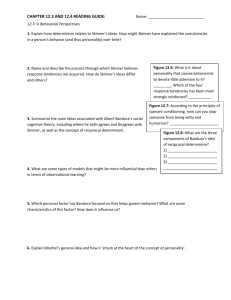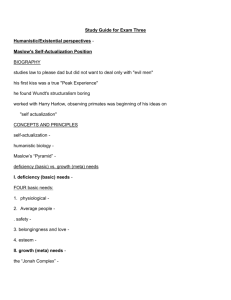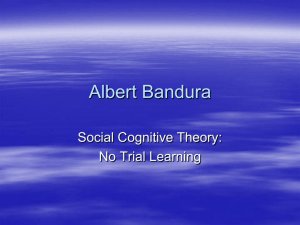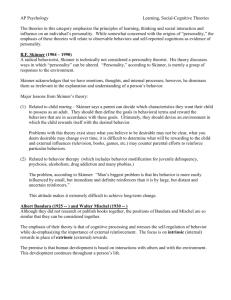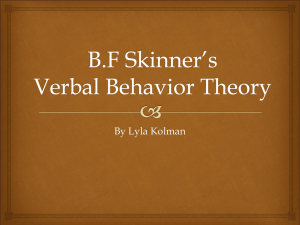NathanDGarst00000000..
advertisement
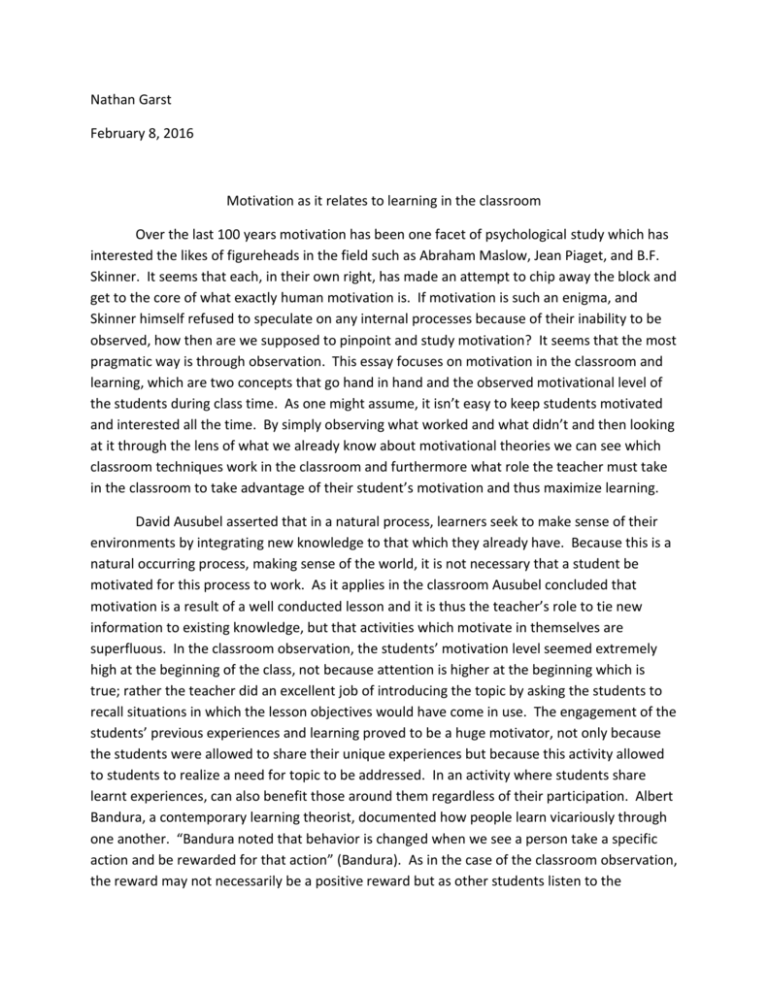
Nathan Garst February 8, 2016 Motivation as it relates to learning in the classroom Over the last 100 years motivation has been one facet of psychological study which has interested the likes of figureheads in the field such as Abraham Maslow, Jean Piaget, and B.F. Skinner. It seems that each, in their own right, has made an attempt to chip away the block and get to the core of what exactly human motivation is. If motivation is such an enigma, and Skinner himself refused to speculate on any internal processes because of their inability to be observed, how then are we supposed to pinpoint and study motivation? It seems that the most pragmatic way is through observation. This essay focuses on motivation in the classroom and learning, which are two concepts that go hand in hand and the observed motivational level of the students during class time. As one might assume, it isn’t easy to keep students motivated and interested all the time. By simply observing what worked and what didn’t and then looking at it through the lens of what we already know about motivational theories we can see which classroom techniques work in the classroom and furthermore what role the teacher must take in the classroom to take advantage of their student’s motivation and thus maximize learning. David Ausubel asserted that in a natural process, learners seek to make sense of their environments by integrating new knowledge to that which they already have. Because this is a natural occurring process, making sense of the world, it is not necessary that a student be motivated for this process to work. As it applies in the classroom Ausubel concluded that motivation is a result of a well conducted lesson and it is thus the teacher’s role to tie new information to existing knowledge, but that activities which motivate in themselves are superfluous. In the classroom observation, the students’ motivation level seemed extremely high at the beginning of the class, not because attention is higher at the beginning which is true; rather the teacher did an excellent job of introducing the topic by asking the students to recall situations in which the lesson objectives would have come in use. The engagement of the students’ previous experiences and learning proved to be a huge motivator, not only because the students were allowed to share their unique experiences but because this activity allowed to students to realize a need for topic to be addressed. In an activity where students share learnt experiences, can also benefit those around them regardless of their participation. Albert Bandura, a contemporary learning theorist, documented how people learn vicariously through one another. “Bandura noted that behavior is changed when we see a person take a specific action and be rewarded for that action” (Bandura). As in the case of the classroom observation, the reward may not necessarily be a positive reward but as other students listen to the anecdotes of their peers, they soon realize that not being able to exhibit the objective skill to be taught can be a negative reinforcement to want to learn it and thus build upon previous experiences, learned or imagined. In the classroom observation, the presence of role-play seemed to be another important motivator. Students were asked to play a role in which they would for a moment become someone else which had the ability to personalize a scenario that would otherwise be far removed from the classroom. Motivational theorist Robert Gagne stresses that practical application of what will be learned is a way to further motivate students. As soon as the activity was introduced there was an observable dramatic shift in motivation. Students began talking and fully assuming the new role and it almost gave a new life to the lesson making it somehow more real than the actual classroom environment. In addition to allowing the students to bridge the gap between theory and real life, role play adds a certain level of anonymity. Role play allows the student to step outside himself and assume the confidence or identity of another person and not risk sounding strange, especially when it applies to language learning. Finally role-play adds variety to classroom tasks. Acting, in addition to being pragmatic in its real life simulation, is entertaining and breaks up monotony. B.F. Skinner thought that, “if you want to motivate students to do something, you define those specific behaviors and then provide reinforcement.” These reinforcements were seen in the variation of tasks and factoring in entertainment which was observed in the role-play. The motivation of the observed class was quite cyclical in its progression, starting out high and then dropping, only to rise again and then fall again. Up until now we have seen the ‘peaks’ of motivation which we can attribute to class activities and teacher role, and so we might be able to deduce that in the ‘valleys,’ where little or no motivation was observed, were attributed to the lack of quality of classroom activities and a change in the teacher role. This could be seen in the grammar and its structure portion of the lesson where the students seemed to be lost. The teacher’s role seemed to change and instead of engaging the student and involving him or her in the process of discovery, the classroom dynamic suddenly became passive. It was also observed that throughout the lesson at any point where there the teacher talking time got to be too lengthy, the students seemed to bore and there was an observable drop in motivation. From this we can conclude that participation in itself is a rewarding a motivating experience. Without extrinsic rewards to motivate the students, this portion of the class relied on intrinsic motivation by excluding the students from the discovery process of ‘finding out’ corporately. Jerome Bruner, another motivational theorist favored discovery learning because he believed it activated curiosity, and in turn intrinsic motivation. Students are motivated by internal or external factors and the responsibility lies on educator to find out exactly what drives motivation in the classroom. As seen by observing a lesson, the educator’s role in building on pre-existing knowledge structures, personalization, entertainment and varying tasks, and finally involving the student in the discovery process seem to inspire students. It is perhaps the ability to combine these elements which lead to motivation in the classroom and ultimately the end goal of learning. Works Cited "Educational Theory of B. F. Skinner." Educational Theory of B. F. Skinner. New Foundations, n.d. Web. 18 Aug. 2013. <http://www.newfoundations.com/GALLERY/Skinner.html>. McLeod, Saul. "Simplepsychology.org." Simplepsychology.org. N.p., 2011. Web. 18 Aug. 2013. <http://www.simplepsychology.org/bandura.html>. "Subsumption Theory (D. Ausubel)." Subsumption Theory. Instructional Design, n.d. Web. 18 Aug. 2013. <http://www.instructionaldesign.org/theories/subsumption-theory.html>.
